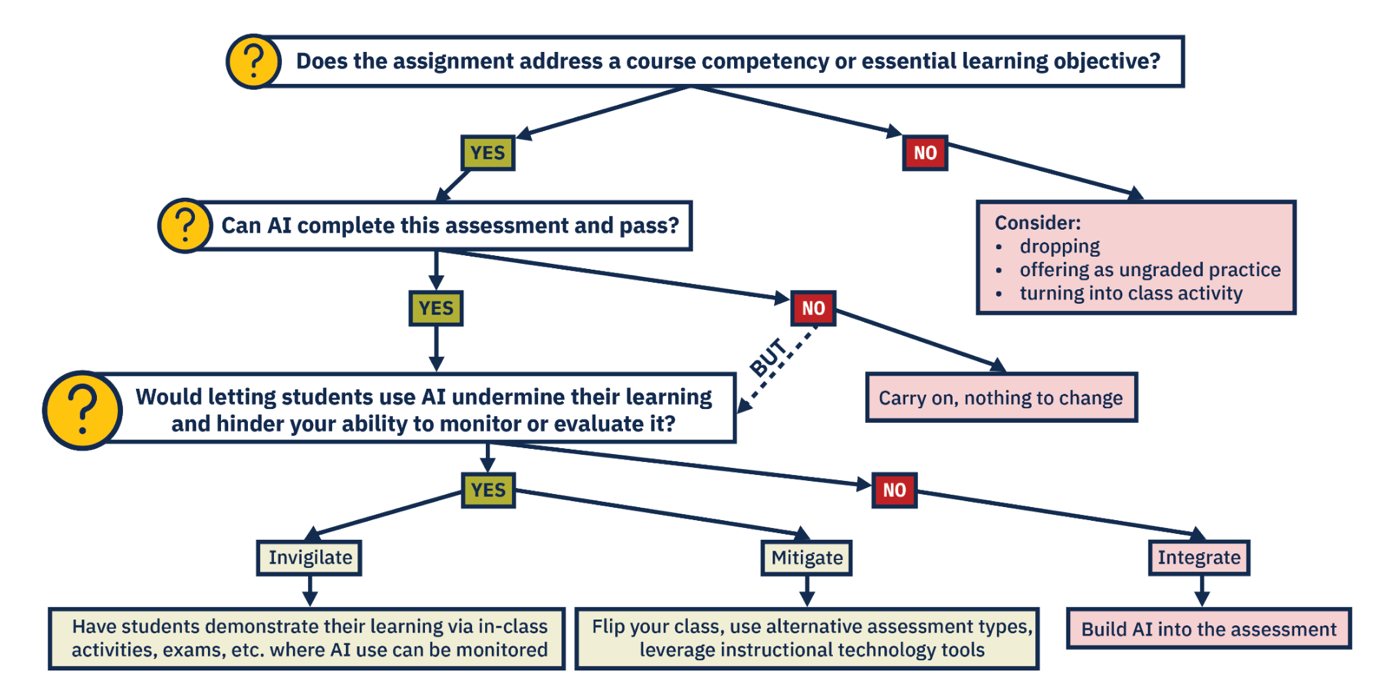Beyond the Ban: Developing GenAI Policies for Your Course
Are you worried about your students’ over-reliance on ChatGPT and other Generative Artificial Intelligence (GenAI) tools in your course? Consider these ‘Top Four Tips’ from the Teaching and Learning Transformation Center (TLTC).
1. Evaluate your assignments
Test out your assignments in a few GenAI tools before distributing them. Consider both what might be harmful about the use of these tools as well as what might be potentially beneficial to students about them.
Use this decision tree to guide your thinking (University of Michigan, 2023)

© 2023 by University of Michigan is licensed under Attribution-NonCommercial-ShareAlike 4.0 International.
How are things looking for your assignments? If you've identified areas where AI might impact learning or assessment, you're already thinking critically about your course design. The good news: there are concrete strategies to address these challenges.
2. Redesign your assignments
While redesigning assignments to account for GenAI presents challenges, it can also be an opportunity to create even more substantive and relevant coursework. Your students will be entering a work environment where AI is present, and your work to help them understand the value of critical thinking as well as of leveraging technology when appropriate will serve them well in the long run. While none of these options are foolproof, combining multiple strategies in addition to communicating with your students will make learning shortcuts with AI less tempting.
Invigilate (or Supervise Assessments)
Observe and evaluate learning in real time. Consider possible alternative exercises.
- Hands-on learning experiences: Labs, field work, simulations, projects
- In-class practice exercises & public scholarship: Deliver lectures by video and have in-class discussions, worksheets, peer teaching, project work, presentations, poster sessions, gallery walks, cold calling, etc.
- In-class accountability: For core skills students need to do without assistance, consider more in-class exams or quizzes so students will see the direct value of completing outside-of-class work on their own. Consider asking students to explain or revise their work during class time.
Mitigate AI Shortcuts to Learning
Encourage thoughtful use or discourage shortcuts.You may also find appropriate times to incorporate AI into your course content and assignments. Some examples include:
- Integrate AI into learning: Guide students to use AI tools, document their process, and reflect on the results and lessons learned
- Explore discipline-specific tools together: For research, images, mapping, coding, etc.
- Critically analyze AI outputs: Have students reflect on accuracies, inaccuracies, utility, and potential downsides
- Process over product: Have students reflect on how they approached a problem or task, submit unfinished work, provide multiple drafts, list questions, submit a google doc with version history, etc.
- Alternative formats and creative works: Have students submit concept maps, reading annotations, infographics, podcasts, drawings, websites, blogs, videos, etc.
- Synthesis and application: Require students to link course concepts to their lives, current events, earlier course learning, required readings, etc.
3. Communicate your policy: frequently and specifically
Be as clear as possible about what GenAI use is/isn’t allowed and when. Articulate this in your syllabus, write specific reminders on each assignment, and have in-class discussions about the policy.
Resource: TLTC example syllabus language
4. Keep learning and exploring
- REVIEW: AI Guidelines for Use at UMD
- SEARCH: AI Tools and Services Available at UMD
- EXPLORE: AI Resources from TLTC
- READ: Talk is cheap: why structural assessment changes are needed (GenAI)
- SCHEDULE: Department-specific workshop facilitated by TLTC; email tltc@umd.edu
- REQUEST: 1:1 consultation with a TLTC specialist
Center for Teaching & Learning, UMass Amherst. How Do I (Re)design assignments and assessments in an AI-impacted world? https://www.umass.edu/ctl/how-do-i-redesign-assignments-and-assessments-ai-impacted-world
Center for New Designs in Learning and Scholarship (CNDLS). (n.d.). AI resources. Georgetown University. https://cndls.georgetown.edu/resources/ai/
Corbin, T., Dawson, P., & Liu, D. (2025). Talk is cheap: Why structural assessment changes are needed for a time of GenAI. Assessment & Evaluation in Higher Education. Advance online publication. https://doi.org/10.1080/02602938.2025.2503964
Corbin, T., Dawson, P., Nicola-Richmond, K., & Partridge, H. (2025). ‘Where’s the line? It’s an absurd line’: Towards a framework for acceptable uses of AI in assessment. Assessment & Evaluation in Higher Education, 50(5), 705–717. https://doi.org/10.1080/02602938.2025.2456207
Derek Bruff. (2023, July 19). Assignment makeovers in the AI age: Essay edition. Agile Learning. https://derekbruff.org/2023/07/19/assignment-makeovers-in-the-ai-age-essay-edition/
Mills, A. (2025, August 19). Guiding students on appropriate AI use: Collaborative approaches [Slide presentation]. University of Nebraska, Kearney, English Department. College of Marin.
Parsons, J. S., Futterman, R., Goff, S. B., Kaczala, C. M., Meece, J. L., & Midgley, C. (1980). Self-perceptions, task perceptions and academic choice: origins and change (pp. 198). Ann Arbor, MI.
Patall, E. A., Cooper, H., & Wynn, S. R. (2010). The effectiveness and relative importance of choice in the classroom. Journal of educational psychology, 102(4), 896.
Rojas, C., Rong, R., & Bloomfield, L. (2025). Allowing Generative AI in Class: Evidence from a Semester-Long Controlled Teaching Study. Available at SSRN. https://papers.ssrn.com/sol3/papers.cfm?abstract_id=5517878
Rundle, K., Curtis, G., & Clare, J. (2020). Why students choose not to cheat. In T. Bretag (Ed.), A research agenda for academic integrity (pp. 100–111). Edward Elgar Publishing. https://doi.org/10.4337/9781789903775.00016
University of Iowa Office of the Provost. (2023, November). Where we are now: Designing assignments in the age of AI. https://provost.uiowa.edu/news/2023/11/where-we-are-now-designing-assignments-age-ai
University of Michigan. (n.d.). Course and assignment (re-)design. GenAI Resources. https://genai.umich.edu/resources/faculty/redesigning-assessments
University of Michigan–Flint. (n.d.). Redesigning assignments. GenAI @ UM-Flint. https://www.umflint.edu/genai/assignments-in-the-ai-era/redesigning-assignments
